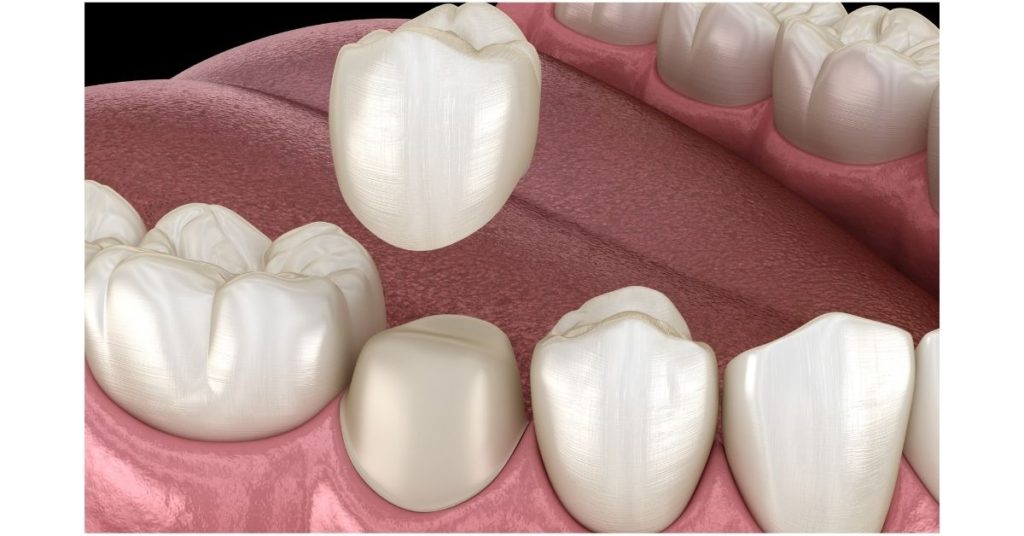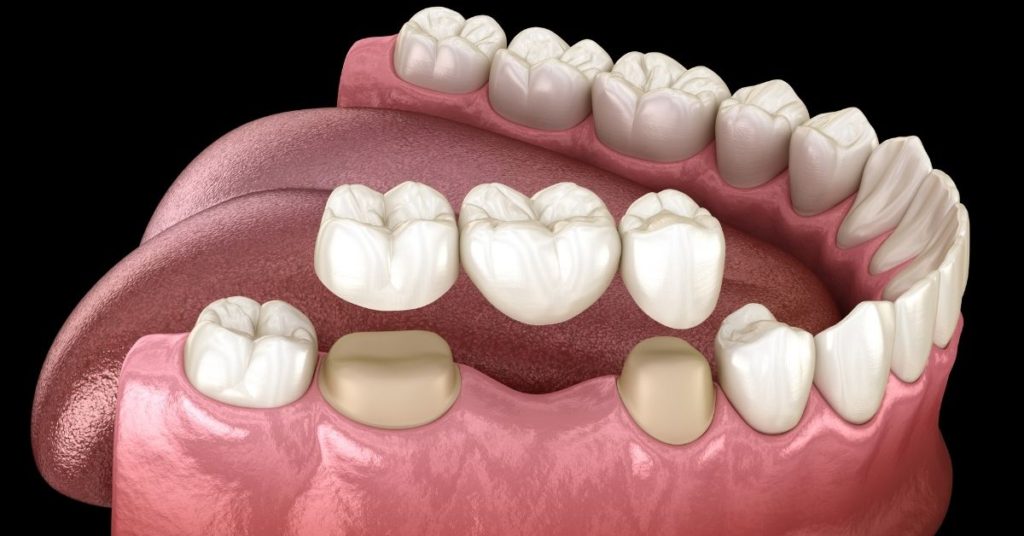Dental crowns and bridges
Dental crowns and bridges are permanently attached, so-called fixed restorations that are placed over prepared tooth stumps or dental implants to replace the visible part of your teeth and restore their original color and shape. Crowns may be necessary, for example, in the case of severely decayed, chipped teeth or in the case of aesthetic defects, or as a preventive measure in cases where the tooth is very sensitive (e.g. after a root canal treatment). A crown or bridge placed on the implanted tooth root can eliminate the aesthetic and health problems caused by tooth loss.
tooth crown:

A dental crown is basically used to cover a single tooth, but there are also multi-unit crowns (consisting of several connected crowns) that can be placed on several teeth at the same time. With the conventional method, the tooth must be ground down in order for it to fit. This means a significant loss of tooth structure, but it offers permanent and strong protection for the remaining tooth structure. With modern crowns, the tooth is prepared with a special method, the so-called shoulder preparation, for maximum protection and aesthetics, so that the crown fits perfectly on the gums, the edge does not protrude and does not irritate the gums.
Types of dental crowns:
Commonly referred to as porcelain crowns, these long-lasting, aesthetic crowns can be made of metal-ceramic (even gold-ceramic), zirconium, or pressed ceramic.
metal-ceramic crown:
The stable framework consists of a metal alloy with a tooth-colored porcelain veneer. Extremely strong, durable, often cheaper than other crown types. The downside is that it has a less natural look and can be problematic for those with metal allergies. To avoid allergic reactions, it can be made of a nickel-free alloy or hypoallergenic gold.
Gold ceramic crown:
A special type of metal-ceramic crown in which a thin gold veneer is placed under the porcelain veneer. The gold is fully biocompatible, does not cause allergies and its antibacterial properties inhibit the growth of bacteria. It fits the tooth very closely, and thanks to the thin framework, less tooth material has to be polished during the preparation.
Zirconium crown:
It consists of a completely metal-free, biocompatible zirconium oxide framework that sits very precisely and, thanks to its tooth-like transparency, enables a completely natural-looking restoration. It is very strong and durable and is also suitable for replacing molar crowns such as metal-ceramic crowns.
Press ceramic crown:
A one-piece crown without a separate framework and cover. This makes them aesthetically superior, but they are more fragile, making them best suited for replacing individual anterior teeth.
Modern dental crowns are manufactured in the dental laboratory using high-precision CAD/CAM (Computer Aided Design/Computer Aided Manufacturing) technology, which means that both the design and the manufacture are computer-controlled.
Bridge:

A bridge is essentially a dental prosthesis consisting of several crowns to correct a tooth defect, also made of metal-ceramic, zirconium or pressed ceramic. The free-standing part of the bridge over the tooth gap, covering the gap, is the bridge element, which is attached to the denture by a crown element on both sides and serves as a buttress. It is a quick and cheap aesthetic solution, but compared to implantation, it has the disadvantage of having to grind down the teeth (the “abutment teeth”) next to the missing tooth, which are usually completely intact. In order to close larger gaps, it can be combined well with an implantation, in which the implants act as abutment teeth.
Course of the treatment:
Traditionally, crowns and bridges are made for your own teeth. The main steps of treatment are:
Assessment of the condition, if necessary with X-rays
Preparation of the affected tooth/teeth by grinding under local anesthesia
Impression taking
Fabrication of the framework for the denture in the dental laboratory, followed by staining of the tooth-colored porcelain veneer
Bonding of the crown/bridge with adhesive cement
Between the preparation and bonding of the final crown, a temporary crown provides polished, sensitive teeth protection and an aesthetic appearance.
frequently asked Questions
Dental crowns are recommended for patients with severely damaged, broken teeth that cannot be restored with fillings. Teeth that have undergone root canal treatment and are therefore vulnerable and even discolored should also be protected with a crown.
Bridges are recommended for patients who have a small tooth gap and want to quickly eliminate it without the need for implants. In combination with an implantation, however, larger gaps can also be treated with a dental bridge.
The teeth usually have to be ground down for the crown or bridge. However, this is done under local anesthesia and is not painful.
Today, fixed dentures are manufactured using precise computer-aided design (CAD/CAM) technology and are veneered with porcelain so that they all have a tooth-colored, esthetic appearance. The difference between the different types of crowns and bridges mainly lies in their natural appearance, durability and price. To choose the right type, it is necessary to take into account the nature and location of the problem to be solved, as well as the patient’s individual needs and financial capabilities.
The average lifespan of a well-made crown or bridge is 8-10 years, but this largely depends on the patient’s oral hygiene habits. With proper care, it is not uncommon for a crown or bridge to stay in place and perform its function for up to 15 years.

Contact us!
Book an appointment online!
Fill out the form, click the login button, and we will contact you soon.
